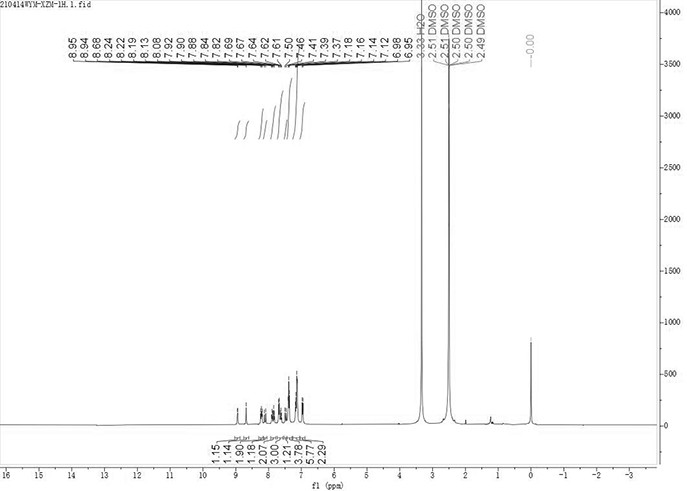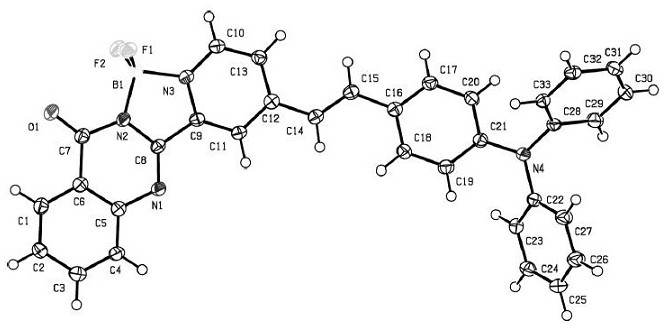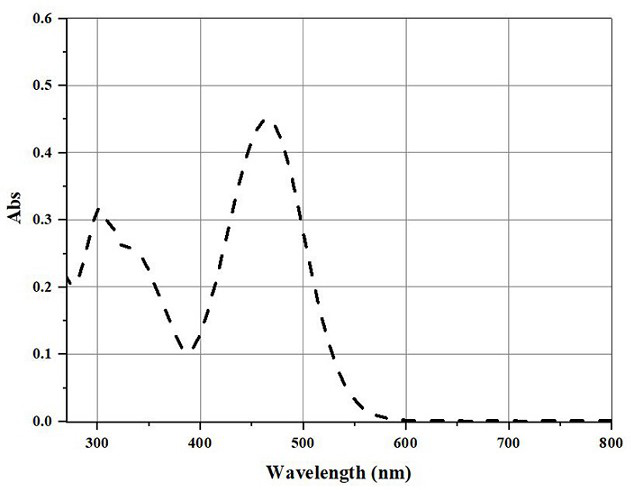Endoplasmic reticulum positioning imaging/light-induced ferroptosis bifunctional probe
A light-induced, endoplasmic reticulum technology, applied in the direction of fluorescence/phosphorescence, microbial measurement/inspection, luminescent materials, etc., can solve the problem of no good monitoring means, no organelle targeting of compounds, and difficult direct observation of lipid peroxidation change process Waiting for the question
- Summary
- Abstract
- Description
- Claims
- Application Information
AI Technical Summary
Problems solved by technology
Method used
Image
Examples
Embodiment 1
[0051]
[0052] In a 100mL reactor, add (E)-2-(4-(4-(diphenylamino)styryl)pyridin-2-yl)quinazolin-4(3H)-one 4.92g (10mmol) , add 50mL of toluene as a solvent, stir and mix evenly, add 1.38mL (10mmol) of triethylamine and boron trifluoride ether complex, heat and reflux, react for 30h, after the reaction, pour the reaction solution into water, wait After the layers were separated, extracted with dichloromethane, and the organic phase was concentrated using a rotary evaporator to remove the solvent. Separation by column chromatography to obtain the target product. The yield was 45%. The following are the NMR and mass spectrometry data of the product:
[0053] 1 H NMR (400 MHz, DMSO-d 6 ) δ =8.94 (d, J = 5.9 Hz, 1H), 8.68 (s, 1H),8.30 – 8.16 (m, 2H), 8.11 (d, J = 16.3 Hz, 1H), 7.94 – 7.78 (m, 2H ), 7.66(dd, J = 19.8, 7.8 Hz, 3H), 7.48 (d, J = 16.3 Hz, 1H), 7.39 (t, J = 7.7 Hz,4H), 7.15 (dd, J = 17.6, 7.5 Hz , 6H), 6.96 (d, J = 8.5 Hz, 2H) ppm.
[0054] 13 C NMR (101 MH...
Embodiment 2
[0074]
[0075] In a 100mL reactor, add (E)-6-(dimethylamino)-2-(4-(4-(diphenylamino)styryl)pyridin-2-yl)quinazoline-4( 5.35g (10mmol) of 3H)-ketone, add 50mL of toluene as a solvent, stir and mix evenly, add 1.38mL (10mmol) of triethylamine and boron trifluoride ether complex, heat and reflux, react for 30h, and the reaction is over Finally, the reaction solution was poured into water, and after layers were separated, it was extracted with dichloromethane, and the organic phase was concentrated by a rotary evaporator to remove the solvent. Separation by column chromatography to obtain the target product. The yield was 45%. The following are the NMR and mass spectrometry data of the product:
[0076] 1 H NMR (400 MHz, Chloroform-d) δ= 9.00 (d, J = 8.5 Hz, 1H), 8.56 (d, J = 1.8 Hz, 1H), 7.86 (s, 1H), 7.52 (d, J = 2.3 Hz, 1H), 7.46 (d, J = 8.1 Hz,1H), 7.45 – 7.39 (m, 2H), 7.39 – 7.34 (m, 1H), 7.32 – 7.25 (m, 4H), 7.29 –7.19 (m, 1H), 7.17 – 7.08 (m, 7H), 7.04 (tt, J = 7.7...
Embodiment 3
[0086]
[0087] In a 100mL reactor, add (E)-2-(4-(4-(diphenylamino)styryl)pyridin-2-yl)benzo[g]quinazolin-4(3H)-one 5.43g (10mmol), add 50mL of toluene as a solvent, stir and mix evenly, add 1.38mL (10mmol) of triethylamine and boron trifluoride ether complex, heat and reflux, react for 30h, after the reaction is completed, the reaction solution Pour into water, wait for the layers to be separated, extract with dichloromethane, and use a rotary evaporator to concentrate the organic phase to remove the solvent. Separation by column chromatography to obtain the target product. The yield was 45%. The following are the NMR and mass spectrometry data of the product:
[0088] 1 H NMR (400 MHz, Chloroform-d) δ= 9.00 (d, J = 8.5 Hz, 1H), 8.57 (d, J = 1.9 Hz, 1H), 8.50 (dd, J = 2.0, 0.7 Hz, 1H), 8.27 (d, J = 1.9 Hz, 1H),7.94 (ddd, J = 7.8, 2.0, 1.2 Hz, 1H), 7.85 (s, J = 8.4 Hz, 1H), 7.61 – 7.47(m, 2H), 7.46 – 7.39 (m, 2H), 7.39 – 7.33 (m, 1H), 7.33 – 7.24 (m, 4H), 7.29 – 7.18 (...
PUM
 Login to View More
Login to View More Abstract
Description
Claims
Application Information
 Login to View More
Login to View More - R&D
- Intellectual Property
- Life Sciences
- Materials
- Tech Scout
- Unparalleled Data Quality
- Higher Quality Content
- 60% Fewer Hallucinations
Browse by: Latest US Patents, China's latest patents, Technical Efficacy Thesaurus, Application Domain, Technology Topic, Popular Technical Reports.
© 2025 PatSnap. All rights reserved.Legal|Privacy policy|Modern Slavery Act Transparency Statement|Sitemap|About US| Contact US: help@patsnap.com



